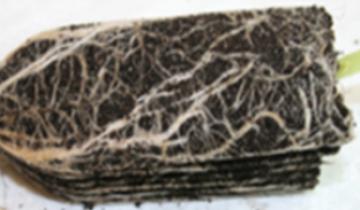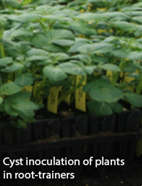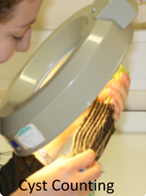Boosting potato breeding for PCN resistance by application of modern technologies

Potato cyst nematodes (PCN), and the species of Globodera pallida in particular, have been spreading steadily across the UK over the past recent decades posing significant threats to the sustainability of the potato industry, especially the seed potato industry, in Scotland. Despite both statutory and agronomic counter measures (primarily rotations and the use of nematicides) that have been taken, the increasing prevalence of Globodera pallida is of concern due to a lack of resistant cultivars with suitable agronomic properties. The loss of clean land at the current rate due to PCN risks a substantial diminution or even collapse of the Scottish potato seed industry within 30 years.
 From the potato breeding perspective, the most effective way to manage PCN and mitigate further loss of seed land is to accelerate the introduction and turnover of potato cultivars with high and durable levels of nematode resistance by deployment of modern breeding technologies.
From the potato breeding perspective, the most effective way to manage PCN and mitigate further loss of seed land is to accelerate the introduction and turnover of potato cultivars with high and durable levels of nematode resistance by deployment of modern breeding technologies.
We are working with JHL potato breeders who are deploying breeding lines containing resistances introgressed from Solanum tuberosum Group andigena and S. vernei. Our aim is to develop highly diagnostic markers for marker assisted selection (MAS) from analysis of next generation sequencing (NGS) datasets generated by state of the art genotyping technologies, such as dRenSeq (based on resistance gene homologs) and genotyping by sequencing (GBS) using bulked segregant analysis (BSA) and genome-wide association study (GWAS) to accelerate and improve the efficiency of PCN-resistance breeding. The durability and effectiveness against different PCN populations of the introgressed resistances is being assessed using populations from the Hutton’s PCN collection.
 We are also exploiting the Commonwealth Potato Collection (CPC) for additional and novel sources of resistances from wild potato species. We are currently mapping resistances to G. pallida in S. multidissectum and S. spegazzinii with the aim of introgressing these resistances into JHL breeding lines using marker assisted selection.
We are also exploiting the Commonwealth Potato Collection (CPC) for additional and novel sources of resistances from wild potato species. We are currently mapping resistances to G. pallida in S. multidissectum and S. spegazzinii with the aim of introgressing these resistances into JHL breeding lines using marker assisted selection.








